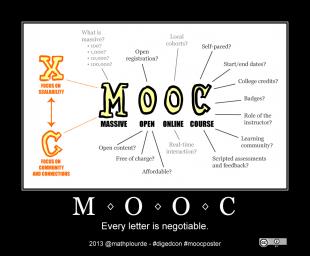Elliott Masie's MOOC Symposium Recap


The MOOC (Massive Open Online Course) phenomenon that has been shaking up higher education for the past few years is slowly beginning to find its way into corporate conversations. Many companies are seeking to better understand the MOOC model and the possibilities for application in their own training programs. It is no surprise then that the Masie Center, a leading think tank exploring the intersection of learning and technology, decided to host a conference around such possibilities—bringing together 70 participants (including myself) at the recent MOOC Symposium in Saratoga Springs, New York. The 3-day event was packed with fantastic discussion and some great takeaways, some of which I will try to summarize for you.
What does MOOC really stand for?
As I stated above, MOOC most commonly stands for Massive Open Online Course. MOOC Symposium host Elliott Masie wasted no time in really digging into the meaning of each of those words, even questioning inclusion of some of the words.
M = Massive
The first group discussion centered around how each of us defined the word “massive.” For many, it was a matter of size—thousands and thousands of students. Elliott challenged us to think beyond numbers. For example, many of us felt massive really meant the lessons being taught were scalable, and could be applied to small or large audiences. We all agreed, however, the real value of the technology and structure behind MOOCs is that their massive nature does not place additional burden on the instructor.
O = Open
Many MOOC platforms, such as Coursera and edX, offer free mass courses that are open to anyone with an Internet connection. Coming from a corporate environment where firewalls and restrictions are a part of daily life meant our group struggled with what the word “open” meant to us. Since many corporate training programs tend to focus training options towards compliance or job-specific skills, we considered that “open” could mean allowing training options to be accessed by a broader range of employees or departments. Additionally, open could also mean the ability to choose your own learning path, as well as how you access the training, such as on a mobile device.
O = Online
We didn’t spend as much time on this letter as we did the other three, as “online” is pretty self-explanatory. That said, many of the conversations from the conference centered on the collaborative nature of MOOCs and how such technology in a corporate environment could either encourage or suppress these interactions. As many employees are already using a number of platforms and applications in both their personal and professional lives, would adding more opportunities for online collaboration overwhelm or excite employees while they train?
C = ??
 I have to admit—Elliott Masie blew my mind when he challenged whether the “C” in MOOC had to stand for “course.” If an instructor is defining the learning objectives, then that is a course. Increasingly, however, learners are defining their own journey. MOOCs allow learners to pick and choose lessons that apply to them and skip those that do not. Other learners will mix and match how they learn, taking the MOOC course for some topics and using forums or discussions to learn more about others. If you eliminate the word course, the possibilities for what MOOCs can be or create are endless. For example, what if the C stood for “certificate” or “community?” What would learning look like in those cases?
I have to admit—Elliott Masie blew my mind when he challenged whether the “C” in MOOC had to stand for “course.” If an instructor is defining the learning objectives, then that is a course. Increasingly, however, learners are defining their own journey. MOOCs allow learners to pick and choose lessons that apply to them and skip those that do not. Other learners will mix and match how they learn, taking the MOOC course for some topics and using forums or discussions to learn more about others. If you eliminate the word course, the possibilities for what MOOCs can be or create are endless. For example, what if the C stood for “certificate” or “community?” What would learning look like in those cases?
Lots of Big Questions (And Big Opportunities!)
The goal of this first MOOC Symposium was not to provide a “how-to” guide to using MOOCs in a corporate environment. Instead, I felt the goal of the gathering was to encourage us explore the possibilities. For example, most modern corporate training programs are focused on course completion as a key metric. Since MOOCs allow learners to come in and out of lessons of their own will, applying them in a corporate setting could fundamentally shift the way we in the business world view completion. If employees aren’t having to complete all lessons, how do we measure competency?
The Symposium has left be both exhausted and ecstatic about the future of MOOCs in corporate education. It is clear that learner choice and collaboration are growing trends that will impact how training programs are designed, even if companies don’t end up using the MOOC structure.
Image Credit: Mathieu Plourde via Flickr



